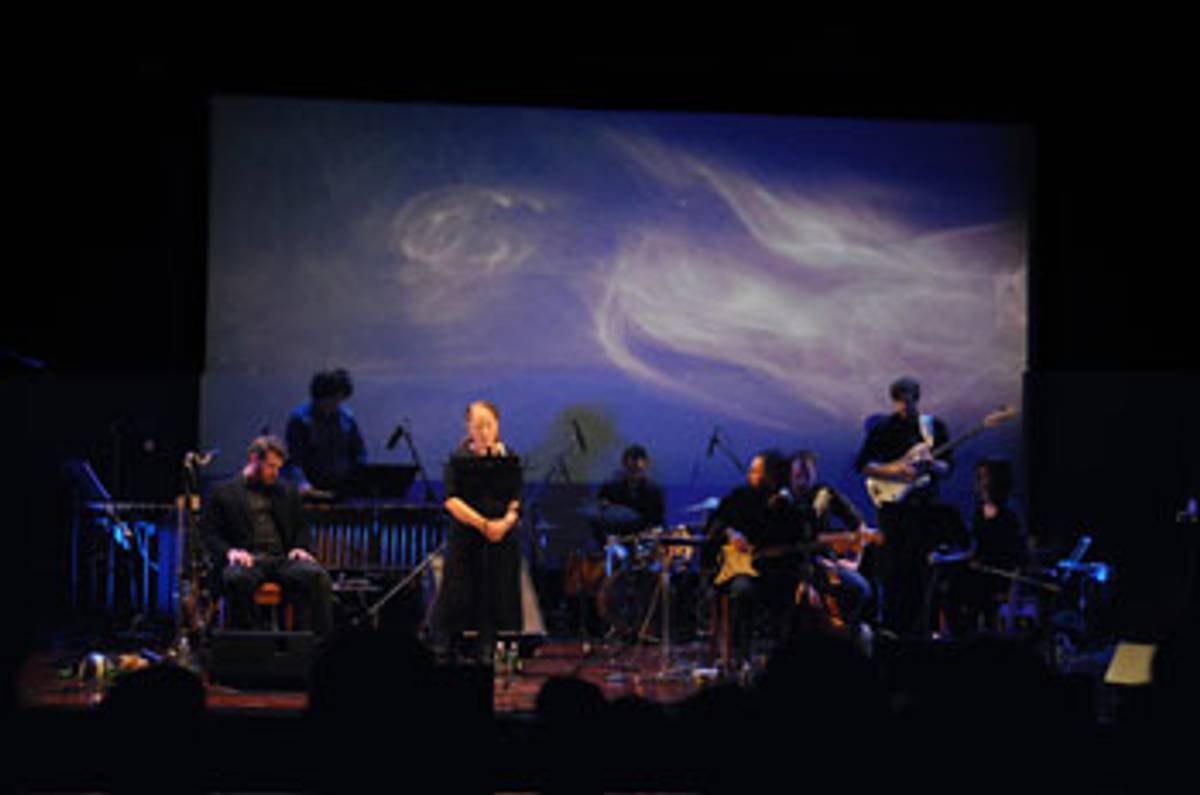How many rock bands would dedicate an entire collection of songs to the Jewish poet and Holocaust survivor Paul Celan? How many rock bands even know who Paul Celan is?
Those two questions flashed through my mind as I listened to the alt-rock ensemble Barbez present Force of Light, a multimedia show built around Celan’s verse, at the Museum of Jewish Heritage—A Living Memorial to the Holocaust a couple of weeks ago. (The music was first released on John Zorn’s Tzadik label in 2007; the set-up at the museum included a video backdrop by director Josh Jesurun.)
Celan does not seem a likely candidate for musical celebration. His work can be dauntingly opaque. His language is by turns playful, somber, and enigmatic. And his personal story—he survived the camps in which both his parents were killed, only to drown himself in the Seine in 1970—can create an undercurrent of menace and despair even when the words themselves are ambiguous.
Yet Barbez was practically created with this material in mind. The band’s leader, guitarist Dan Kaufman, is a composer with a broad emotional palette and a gift for transforming difficult source material into eccentric rock songs. (He has also dedicated a tune to the philosopher and Nazi sympathizer Martin Heidegger.) His settings of Celan’s poetry, though often brooding, are also quite varied, beginning quietly before ramping up to raucous, thrashing climaxes.

Such was the case with “Aspen Tree,” a poem that Celan wrote for his mother after the war. At first, violin and theremin floated dreamily over a repetitive guitar pattern. As the playwright and poet Fiona Templeton declaimed the line “My mother’s heart was ripped by lead” in her rich Scottish burr, the band launched itself into a gathering storm of ever-greater volume and dissonance, concluding with a weeping theremin melody over the phrase “My gentle mother cannot return.”
Kaufman named Barbez for the multiethnic Parisian neighborhood where he once lived. Initially based in Brooklyn, its members have since dispersed across the United States and Europe; they include percussionist Danny Tunick on marimba and vibes, as well as violinist Catherine McRae, clarinetist Peter Hess, and theremin player Pamelia Kurstin. The band is currently on an international tour.

This array of instruments is itself enough to set the band apart; combined with Kaufman’s carefully structured arrangements, it allows Barbez to tread a fine line between progressive rock and modern chamber music. The band bounces from the kind of intricate, cyclical guitar parts found in African pop to delicate acoustic interludes and frenzied free improvisation, often within the confines of a single tune. The results are sometimes joyous, sometimes violent, and always appealing, which, given the setting of the Celan performance, made for a few awkward moments. Every time I found myself tapping my foot, bopping my head, or showing any other visible sign of pleasure, I couldn’t help feeling a twinge of guilt. Is it permissible to rock out at a Holocaust museum? How can something that sounds so good feel so wrong?
My sense of unease was amplified by the ambivalence I feel toward Holocaust memorials in general. As I walked through the museum’s gift shop, browsing the umbrellas and tote bags emblazoned with the Hebrew word zachor (“remember”), I wondered if the structures and institutions that we erect to memorialize the Shoah and its victims can unintentionally devalue it, diminishing its power to shock and appall. There’s a good argument to be made for taking every opportunity to remind people never to forget. But there’s also something unsettling about seeing the worst genocide of the 20th century marketed using the same tools as a PBS fundraiser or the souvenir shop at the Museum of Natural History.

Force of Light was itself mercifully free of such complications, in part because of its limited ambition”the project is meant specifically as an homage to Celan, and only treats the Holocaust by extension”and in part because Kaufman’s music is so perfectly suited to the task. (Less so the video component, which presents a series of rather puzzling images, from drifting smoke to snow falling around a street lamp. What these have to do with Celan’s verse, I have no idea.)
“Count the Almonds,” for example, provides an ideal musical complement to Celan’s ambivalent remembrance of the classic Eastern European Jewish snack of raisins and almonds. (“Render me bitter/Number me among the almonds.”) As is often the case with Kaufman’s music, the tune has a slightly ominous tinge (as does the song’s subject matter—Celan biographer John Felstiner noted that Zyklon B was said to have smelled of almonds). It begins as a dark tapestry of sinuous, interlocking melodies before breaking into light, chiming vibraphone tones, ringing guitar patterns and soaring theremin and violin lines, and concludes with a savage, churning free-for-all.
Here and elsewhere, the band’s volatility and naked emotionalism further sharpens the already unsettling quality of Celan’s words. By offering such focused and effective tribute to the life and work of a single human being, Kaufman also honors all the others who were consumed by the same darkness.
Listen to Nextbook’s interview with Dan Kaufman here.
Alexander Gelfand is a recovering ethnomusicologist, a sometime jazz pianist, and a former West African drummer. His work has appeared in the New York Times, the Chicago Tribune, the Forward, and elsewhere.